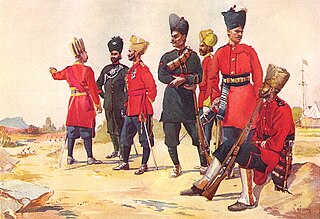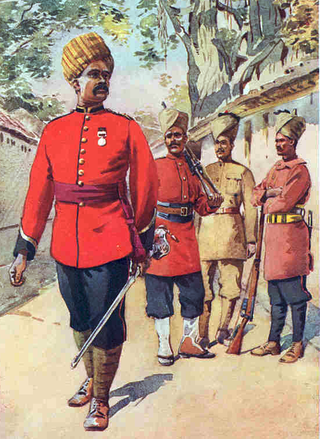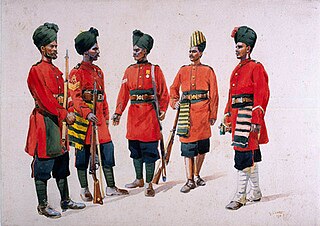Related Research Articles

The Kumaon Regiment is one of the oldest infantry regiments of the Indian Army. The regiment traces its origins to the 18th century and has fought in every major campaign of the British Indian Army and the Indian Army, including the two world wars, and is one of the highest decorated regiments of the Indian Army.

The 2nd Queen Victoria's Own Rajput Light Infantry, commonly shortened to 2nd Rajputs, was a regiment of the British Indian Army. Raised in 1798, it was amalgamated with five other Rajput regiments in 1922.
The 41st Dogras was an infantry regiment of the British Indian Army. The regiment was raised as the 41st (Dogra) Bengal Infantry in 1900 in Jullundur by Major E.T. Gastrell.
The 9th (Secunderabad) Division was an infantry division formation of the British Indian Army. It was part of the Southern Army and was formed in 1904 after Lord Kitchener was appointed Commander-in-Chief, India between 1902 and 1909. He instituted large-scale reforms, including merging the three armies of the Presidencies into a unified force and forming higher level formations, eight army divisions, and brigading Indian and British units. Following Kitchener's reforms, the British Indian Army became "the force recruited locally and permanently based in India, together with its expatriate British officers."
The 17th Indian Division was formed in 1917 from units of the British Indian Army for service in the Mesopotamia Campaign during World War I. After the war, it formed part of the occupation force for Iraq and took part in the Iraq Rebellion in 1920. In August 1923, the division was reduced to a single brigade.

The Imperial Service Troops, officially called the Indian States Forces after 1920, were auxiliary forces raised by the princely states of the Indian Empire which were deployed alongside the Indian Army when their service was required. The Imperial Service Troops were inaugurated in 1888 by the Viceroy of India. At the beginning of the 20th century, their total numbers were about 18,000 men.
The 108th Infantry were an infantry regiment of the British Indian Army. The regiment traces their origins to 1768, when they were raised as the 1st Battalion, Bombay Sepoys.

The 112th Infantry were an infantry regiment of the East India Company's Bombay Army and later the British Indian Army. The regiment traces their origins to 1796, when they were raised as the 2nd Battalion, 6th Regiment of Bombay Native Infantry.

The 104th Wellesley's Rifles were an infantry regiment of the British Indian Army. They could trace their origins to 1775, when they were raised as the 5th Battalion, Bombay Sepoys and presently its designation is 3 Guards of Indian Army.

The 9th Bhopal Infantry was an infantry regiment of the British Indian Army.It was raised by Nawab of Bhopal in 1818 near Sehore. It was re-raised in 1859, as the Bhopal Levy. The regiment was disbanded for participating in war against British during 1857. It was designated as the 9th Bhopal Infantry in 1903 and became 4th Battalion (Bhopal) 16th Punjab Regiment in 1922. In 1947, it was allocated to the Pakistan Army, where it continues to exist as 17th Battalion The Punjab Regiment / 17 Punjab Haidri.
The 97th Deccan Infantry was an infantry regiment of the British Indian Army. They could trace their origin to 1794, when they were the 3rd Battalion of the Aurangabad Division in the Hyderabad State army. Which took part in the Battle of Seringapatam in the Fourth Anglo-Mysore War.
The 79th Carnatic Infantry was an infantry regiment of the British Indian Army. They could trace their origins to 1777, when the 20th Carnatic Battalion was raised from sub-units of the 1st, 3rd, 8th and 16th Carnatic Battalions.

The 61st Pioneers were an infantry regiment of the British Indian Army. They trace their origins to 1758, when they were raised as the 1st Battalion Coast Sepoys.
The 80th Carnatic Infantry were an infantry regiment of the British Indian Army. They could trace their origins to 1777, when they were raised as the 21st Carnatic Battalion, by enlisting men from the 2nd, the 6th, the 12th and the 15th Carnatic Battalions.
The 95th Russell's Infantry were an infantry regiment of the British Indian Army. They could trace their origins to 1813, when they were raised as the 2nd Battalion of the Russell Brigade for the Princely state of Hyderabad. Until 1853, the regiment was part of the Nizam of Hydrabad's Army, then after signing of a treaty with the then Governor-General of India, The Nizam's Contingent was renamed as the Hyderabad Contingent and became part of the regular Indian Army.
The 96th Berar Infantry were an infantry regiment of the British Indian Army. They could trace their origins to 1797, when they were raised as the 2nd Battalion of the Aurangabad Division for the Princely state of Hyderabad. Until 1853, the regiment was part of the Nizam of Hydrabad's Army then after signing of a treaty with the then Governor General of India, The Nizam's Contingent was renamed as the Hyderabad Contingent and became part of the regular Indian Army.
The 98th Infantry was an infantry regiment of the British Indian Army. It could trace its origins to 1788, when it was raised as the 1st Battalion of the Ellichpur Brigade for the Princely state of Hyderabad. Until 1853, the regiment was part of the Nizam of Hydrabad's Army; then, after the signing of a treaty with the then Governor General of India, the Nizam's Contingent was renamed the Hyderabad Contingent and became part of the regular Indian Army.
The 99th Deccan Infantry were an infantry regiment of the British Indian Army. They could trace their origins to 1788, when they were raised as the 1st Battalion of the Ellichpur Brigade for the Princely state of Hyderabad. Until 1853, the regiment was part of the Nizam of Hydrabad's Army then after signing of a treaty with the then Governor General of India, The Nizam's Contingent was renamed as the Hyderabad Contingent and became part of the regular Indian Army.

The 103rd Mahratta Light Infantry were an infantry regiment of the British Indian Army. They could trace their origins to 1768, when they were raised as the 2nd Battalion, Bombay Sepoys. The regiment was first in action in the Mysore Campaign during the Third Anglo-Mysore War, quickly followed by the Battle of Seedaseer and the Battle of Seringapatam in the Fourth Anglo-Mysore War. Their next action was at Beni Boo Ali against pirates in Eastern Arabia and the Persian Gulf region led the East India Company to carry out a punitive expedition in 1819 to Ras al Khaimah which destroyed the pirate base and removed the threat from the Persian Gulf.

The Nizam's Contingent, later Hyderabad Contingent, was a British-officered army of the Nizam of Hyderabad.
References
- ↑ "Nanded District". maharashtra.gov. Retrieved 28 September 2009.
- ↑ "warpath". Archived from the original on 28 November 2003.
- ↑ Sumner p.15
- Barthorp, Michael; Burn, Jeffrey (1979). Indian infantry regiments 1860-1914. Osprey Publishing. ISBN 0-85045-307-0.
- Rinaldi, Richard A (2008). Order of Battle British Army 1914. Ravi Rikhye. ISBN 978-0-9776072-8-0.
- Sharma, Gautam (1990). Valour and sacrifice: famous regiments of the Indian Army. Allied Publishers. ISBN 81-7023-140-X.
- Sumner, Ian (2001). The Indian Army 1914-1947. Osprey Publishing. ISBN 1-84176-196-6.
- Moberly, F.J. (1923). Official History of the War: Mesopotamia Campaign, Imperial War Museum. ISBN 1-870423-30-5
- ↑ "Silver spoon, 94th Russell's Infantry, 1904 | Online Collection | National Army Museum, London". collection.nam.ac.uk. Retrieved 29 August 2024.